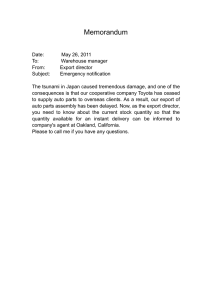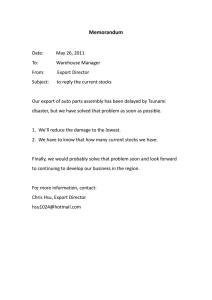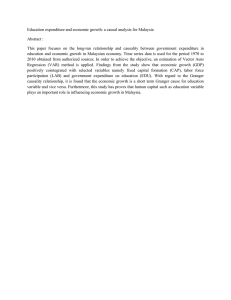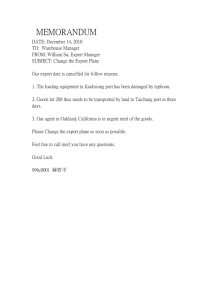IS THE EXPORT LED GROWTH HYPOTHESIS VALID FOR MALAYSIA? Mutalip
advertisement
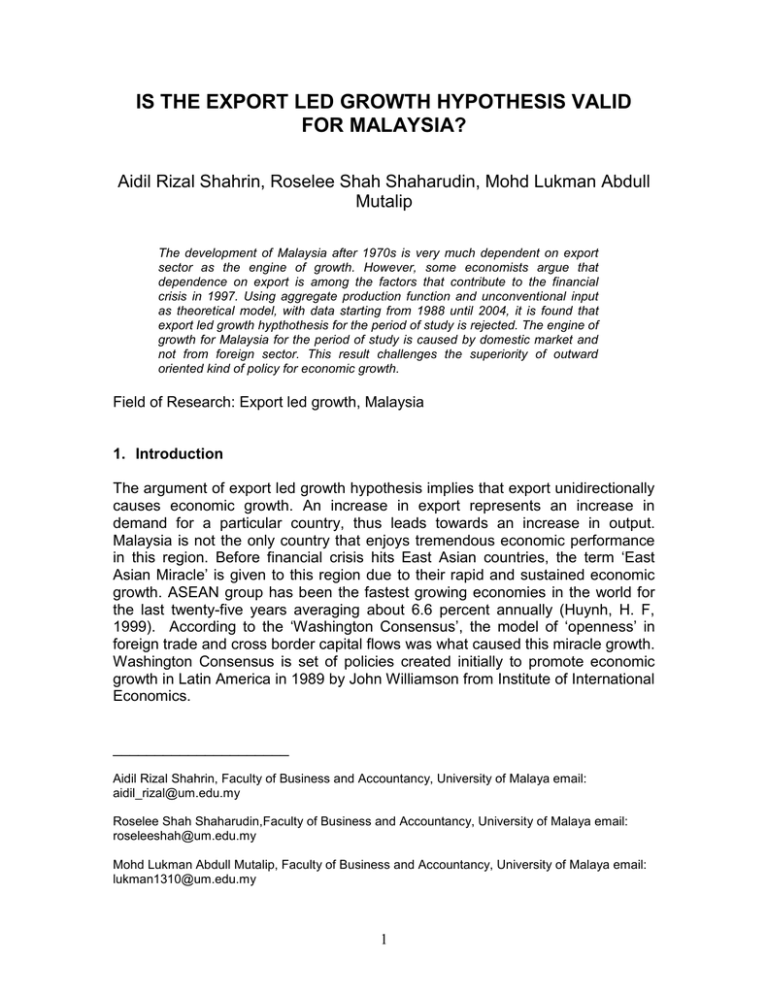
IS THE EXPORT LED GROWTH HYPOTHESIS VALID FOR MALAYSIA? Aidil Rizal Shahrin, Roselee Shah Shaharudin, Mohd Lukman Abdull Mutalip The development of Malaysia after 1970s is very much dependent on export sector as the engine of growth. However, some economists argue that dependence on export is among the factors that contribute to the financial crisis in 1997. Using aggregate production function and unconventional input as theoretical model, with data starting from 1988 until 2004, it is found that export led growth hypthothesis for the period of study is rejected. The engine of growth for Malaysia for the period of study is caused by domestic market and not from foreign sector. This result challenges the superiority of outward oriented kind of policy for economic growth. Field of Research: Export led growth, Malaysia 1. Introduction The argument of export led growth hypothesis implies that export unidirectionally causes economic growth. An increase in export represents an increase in demand for a particular country, thus leads towards an increase in output. Malaysia is not the only country that enjoys tremendous economic performance in this region. Before financial crisis hits East Asian countries, the term ‘East Asian Miracle’ is given to this region due to their rapid and sustained economic growth. ASEAN group has been the fastest growing economies in the world for the last twenty-five years averaging about 6.6 percent annually (Huynh, H. F, 1999). According to the ‘Washington Consensus’, the model of ‘openness’ in foreign trade and cross border capital flows was what caused this miracle growth. Washington Consensus is set of policies created initially to promote economic growth in Latin America in 1989 by John Williamson from Institute of International Economics. _____________________ Aidil Rizal Shahrin, Faculty of Business and Accountancy, University of Malaya email: aidil_rizal@um.edu.my Roselee Shah Shaharudin,Faculty of Business and Accountancy, University of Malaya email: roseleeshah@um.edu.my Mohd Lukman Abdull Mutalip, Faculty of Business and Accountancy, University of Malaya email: lukman1310@um.edu.my 1 It is obvious that dependence on export as an engine of growth exposes a country to the danger of vulnerability of growth of its trading partners. Terrorist attack on 11 September 2001 had caused Malaysia’s export to decline from RM 373,270 million in 2000 to RM 334,284 million in 2001. Severe Acute Respiratory Syndrome (SARS) in 2003 had also influenced the negative development of export due to adverse external environment. If a country’s domestic demand is not strong to support slowdown in external demand, export led growth strategies for growth will eventually fail. The main focus of this paper is to find empirical supports whether export causes growth after the financial crisis. The findings of this paper will give some insights into whether Malaysia should rely on export oriented trade regime (EO) or pursue another alternative for development. 2. Literature Review Economists have long argued the role of export towards economic growth. As Asian countries experienced crisis in 1997, among the first policy options available to stimulate growth was export led strategy. Sprout and Weaver, (1993) argue that openness or export in general does not promote growth, but rather specialization in manufacturers and that the growth of the manufacturing exporting countries may have been constrained to some extent by the growth of their trading partners. Most of the literatures on export-led growth in Asia are silent on the possibility of global demand constraints (Blecker, R.A., 2000). As hypothesized by Palley, I.T, (2002), export led growth operates via hierarchical process with less developed newcomers replacing maturing export economies in which surplus labor supplies have been exhausted and wages are rising. Krugman P. (1994) hypothesizes that Asian growth is similar to the Soviet Union in its high growth era where the economy was driven by extraordinary growth in inputs such as labor and capital rather than by gains in efficiency. Blecker, R.A. (2000) argues that reliance on export growth suffers from ‘fallacy composition’. The reason is that, if too many countries try to simultaneously rely on export-led growth policies to stimulate growth with a given global condition, the market for developing countries’ exports is limited by the capacity of the industrial nations. The arguments that export led growth have harm developing countries are discussed by Palley, I. T, (2002). He argues that that export led growth policy has tilted the focus away from development rooted in domestic market growth, placed developing countries in race-to-the bottom competition, placed workers in developing countries in conflict with workers in industrialized countries and harmed global economy by creating an environment of excess capacity and deflation. The attributes of export having lost their importance in industrialized countries are brought forward by Afxentiou and Serletis (1991). Their study finds that out of 16 countries, only two countries support the argument. Ghatak (1997) who tests 2 ELG hypothesis for the period of 1955-90 in Malaysia supports the hypothesis that aggregate exports Granger cause real GDP and non-export GDP. This results was later supported by Zulkornain Yusop et al. (2001) using data from 1959-2000. On the contrary, Ahmad Zubaidi and Salim Rashid (1999) who segregate the export data into manufacturing and agricultural exports reject ELG hypothesis since they found that there was feedback causal relationship. Khalafalla and Webb (2001) segregate the data for Malaysia into primary and manufactures exports in two periods 1965-1980 and 1981-1996. The argument for this disaggregation was due to structural change of Malaysian policy where the first period focus on import substitutions while the next period used policy that favored export-led growth. Their finding supports the hypothesis for the period 1965-80 but rejected the hypothesis for 1981-96 periods. This mix result was probably due to structural change in Malaysian economy. In another study, Islam (1998) who uses cross sectional analysis also reject the export led growth hypothesis. However, none of the country specific study for Malaysia focuses on the government size as economic growth variables. As Love (1994) argues, the expansion of public sector for a long period may itself play the role as engine of growth. 3. Methodology and Research Design Using quarterly data from the Malaysian Department of Statistics and Malaysian Treasury Department over a series of six years from 1998 to 2004, this study attempts to investigate the validity of export growth hypothesis on Malaysian economic growth. a. Cointegration The Granger test for causality is not valid if the time series variables are cointegrated (see e.g., Ghatak et al., 1997; Ahmad and Harnhirun, 1996; Bahmani-Oskoee and Alse, 1993). Based on Engle and Granger (1987), cointegration occurs when two variables integrated in the same order I(d), but have some linear combination of the two that generates series which is I(0), thus the variables are said to be cointegrated to the order of d, CI(d). In a more simple way, we can say that the two non-stationary series moves together through time without drifting too far apart. For that reason, the first step is to examine the order of integration on the series followed by examining the existence of the cointegtration using Johansen and Juselius (1990) Multivariate Cointegration test. Johansen and Juselius (1990) test involved three steps. The first step involves the determination of the order of integration. Second, it estimates cointegrating regression with VAR model and lastly if the series is cointegrated, then Vector Error Correction Model will be applied. Consider a VAR of order p: 3 yt = A1yt-1 + ….. +Apyt-p + Bxt + εt where yt is a k-vector of non-stationary I(1) variable, xt is a d-vector of deterministic variables, and εt is a vector of innovations. We rewrite the VAR as: p-1 ∆yt = ∏yt-1 + ∑ ΓiΔyt-i + Bxt + εt i=1 where: p p Π = Σ Ai – I, Γi = - Σ Aj i=1 j=i+1 If the coefficient matrix Π has reduced rank r<k (k is the number of endogenous variable), then there exist k х r matrices α and β each with rank r such that Π = α β’ and β’yt is I(0). r is the number of cointegration relations and each column of β is the cointegrating vector. Two likelihood ratio test statistics is used to determine the cointegration rank as suggested by Johansen (1995): i) Trace test k τtrace = - T Σ log(1-λi) i=r0+1 where λi is the i-th largest eigenvalue of the Π matrix (λ1 > λ2 > λ3 > ……. λk). The relevant test statistic is: H0 = r ≤ r0 (no cointegration) H1 = r r0+1(cointegrate) ii) Maximum eigenvalue test This test is related to trace statistics but the alternative hypothesis has been changed. This test is computed as: τmax = -T log (1-λr+1) where the hypotheses are: H0 = r ≤ r0 (no cointegration) H1 = r = r0+1(cointegrate) The idea of changing alternate hypothesis is to try to improve the power of the test by limiting alternative to a cointegration rank which is just one more than under the null hypothesis. The critical value for this test is derived from MacKinnon-Haug-Michelis (1999) where they use response surface regressions based on simulation experiments that are used to calculate asymptotic distribution functions for the Johansen-type likelihood ratio tests for cointegration. However, if we find two or more cointegration relationships, we need to adjust our critical value. Based on Emilio (2001), if the sample size is 100 or smaller (finite sample size), correction of critical value is necessary. b. Vector error Correction Model (VECM) If a set of variables is found to be cointegrated, error correction representation term must be included in the VAR model (Ahmad, 2001). With the existence of 4 cointegration between two or more variables, there exists causality at least in one direction (Engle and Granger, 1987). However, most of the studies using time series data found that exports and GDP do not cointegrate, thus, the long run relationship between this two variables do not exist (see e.g., Ahmad, 2001). This is part of the reasons why most researchers who use times series data reject the ELG hypothesis. VEC is a restricted VAR designed for non-stationary series that are known to be cointegrated. It has cointegration relations built into the specification so that it restricts the long run behavior of the endogenous variables to converge to their cointegrating relationships while allowing for short run adjustment. The direction of Granger causality can only be detected through the VECM derived from the long run cointegrating vectors. The VECM also allows us to distinguish between short run and long run Granger causality. The short run causal effect is indicated by t-test of the explanatory variables (in first difference) and for long run causal relationship is determined through the significance of the of the lagged error-correction term (ECT) which contain long run information (Zubaidi and Rashid, 1999). Let us take a simple bivariate system, with one cointegration equation and no lagged differenced terms. The equation is: y2,t = y1,t Thus, the VEC model is: y1,t = 1(y2,t-1 -y1,t-1) + 1,t y2,t = 2(y2,t-1 -y1,t-1) + 2,t This term, (yi,t-1 -yi,t-1), represent an error correction term, i,t, innovation and I is the speed of adjustment. In the long run, the right hand side variables will be zero. However, VEC will be used if the series is cointegrated and with the same order. 4. Discussion of Findings a. Unit root Table 1.0 shows that all the series are stationary after first difference with 1% significant level. No further test is needed since the series are already stationary in first difference. Thus, we conclude that all the series is integrated in the same order which is I(1). 5 Table 1.0: Unit root test of first difference Variables Augmented Dickey-Fuller (ADF) test Constant Constant with without trend trend ∆LOGGDP -3.2137(4)** -5.1385(1)*** ∆LOGE -4.8576(0)*** -4.7531(0)*** ∆LOGEMP -8.8143(0)*** -8.6327(0)*** ∆LOGG -4.9961(1)*** -4.8554(1)*** ∆LOGGFC ∆LOGI * ** *** b. -5.9708(0)*** -5.8382(0)*** -4.6497(0)*** -4.5196(0)*** Significant at a 10% level Significant at a 5% level Significant at a 1% level Phillips-Perron (PP) test Constant without trend -8.8884(22)*** -4.8543(4)*** -8.8771(1)*** 20.7624(10)*** -6.1062(1)*** -4.6469(2)*** Constant with trend -9.3153(22)*** -4.7382(5)*** -8.7182(1)*** -20.2524(10)*** -5.9443(1)*** -4.5116(2)*** Cointegration test Prior to the application of Johansen cointegration, the series should be integrated with the same order. Based on the above result, we can proceed with the cointegration test since all the series are integrated in the same order I(1). Table 1.1: Trace test for multivariate model Hypothesize d No. of CE(s) Eigenvalue Trace Statistic 0.05 Critical Value Prob.** None * At most 1 At most 2 At most 3 At most 4 At most 5 139.8431 84.28317 48.50371 25.83698 12.09445 4.258678 117.7082 88.80380 63.87610 42.91525 25.87211 12.51798 0.872262 0.734241 0.568077 0.398893 0.251896 0.145919 6 0.0010 0.1014 0.4820 0.7462 0.8055 0.7044 Table 1.2: Maximum Eigenvalue test for multivariate model Hypothesize d No. of CE(s) Eigenvalue Max-Eigen Statistic 0.05 Critical Value Prob.** None * At most 1 At most 2 At most 3 At most 4 At most 5 55.55993 35.77946 22.66673 13.74254 7.835769 4.258678 44.49720 38.33101 32.11832 25.82321 19.38704 12.51798 0.872262 0.734241 0.568077 0.398893 0.251896 0.145919 0.0022 0.0953 0.4427 0.7442 0.8359 0.7044 Notes: Max-eigenvalue test and trace test indicates 1 cointegrating eqn(s) at the 0.05 level * denotes rejection of the hypothesis at the 0.05 level **MacKinnon-Haug-Michelis (1999) p-values The trace test and the maximum eigenvalue are conducted with the inclusion of intercept and trend. Based on the results presented in tables 1.1 and 1.2, the null hypothesis of no cointegration is soundly rejected. However at r = 2, both tests are unable to reject null hypothesis since one stationary linear combination among the series appear. The diagnostic check to determine the lag structure employed in this VAR model are presented in table 1.3. Table 1.3: Diagnostic check for multivariate model No. of lags LM-Stat JarqueChi-sq Bera 1 41.70803*** 18.1453*** 261.589*** Notes: *** Significant at a 1% level Null hypothesis of no serial correlation is accepted at 1% significant level based on LM-Stat, showing the appropriateness of the lag structure. Normality for both models based on Jarque-Bera shows that the residual are normally distributed. Thus, based on the result above, the VAR lag length is appropriate and the residual is well behaved. Since the series are cointegrated for multivariate model, we proceed with vector error correction model (VECM). c. Causality test based on VECM Existence of causality at least in one direction is confirmed among multivariate models. This is due to cointegration of the series based on above finding. The study proceeds with multivariate model by using VECM where we can determine the short run and long run causality. The result of VECM is presented below: 7 Table 1.4: Vector Error Correction Model Independent Variables Dependent LOGGDP LOGE LOGGFC LOGE LOGG Variable MP 0.73041 0.55815 -2.31672** LOGGDP 0.07187 LOGE 1.01439 - -1.17230 -1.03055 0.08142 1.450 76 -3.93310*** 2.36129 ** -0.19439 1.393 13 LOGGFC -0.39360 0.30497 LOGEMP 0.04386 1.48967 0.22925 1.09923 2.15298 3.12067*** ** LOGG 1.26827 LOGI 1.26898 LOG I 0.531 50 0.258 01 0.204 17 0.35696 -1.89787 0.83414 0.66884 Notes: The t-statistic test of the significance of the lagged values of the independent variables and error correction term (ECT). Residual test shows no serial correlation (not reported). Based on table 1.4, we can conclude that real exports does not Granger cause GDP or vice versa. This result rejects the ELG hypothesis and consistent with Khalafalla, K.Y. and A.J. Webb, (2001) for sub-period of 1981:1Q to 1996:4Q, where they found that export led growth hypothesis is strongly rejected compared to the previous sub-period of study from 1965:1Q to 1980:4Q. What really happened to Malaysia during the period of study that makes export led growth hypothesis losses its validity? Malaysia’s export growth has already slowed prior the crisis especially in 1996 and 1997 with an average of 20.3% for the period of 1990-95, whereby it declined to 5.8% in 1996 and 0.7% in 1997. This slowdown was mainly due to loss in competitiveness of Malaysia’s export (Hussain, M. and Radelet, S., 2000). Akyuz et al. (2002) argue that an increase in exports not associated with increase in domestic savings will not translate into investment and growth. They conclude that for growth to be sustained, it requires mutually reinforcing dynamic interactions among exports, savings and investment where it is characterized by continuously rising exports, domestic savings and investment, both in absolute term and for most part of the industrialization process, as a proportion of GDP. 8 ECT(T1) 2.21115 ** 1.92354 * 3.58044 *** 1.39882 4.16512 *** 0.10703 Table 1.5a: Gross National Saving and Gross Domestic Investment Years Gross National Saving Gross Domestic (% of GDP) Investment (% of GDP) 1951-1960 23.2 15.3 1961-1970 21.5 19.9 1971-1980 26.2 26.3 1981-1990 27.4 30.7 1991-1994 30.0 36.1 Source: Akyuz et al Table 1.5b: Gross National Saving and Gross Domestic Investment Years Gross National Saving Gross Domestic (% of GDP) Investment (% of GDP) 1998 39.9 26.7 1999 38.3 22.4 2000 36.5 27.3 2001 32.2 23.9 2002 31.9 23.8 2003 34.6 21.4 Sources: IMF Financial Statistics year books Tables 1.5a and 1.5b explore the percentage of savings to GDP from 1951 to 2003. Starting from 1951 until 1994, Malaysia’s Gross National Savings and Gross Domestic Investment have increased tremendously which might explain its impressive growth before financial crisis. However, beginning 1998, Malaysia’s Gross Domestic Investment decreased (except for year 2000) to the same level of investment that the country experienced in the period of 19711980. However, the level of savings for Malaysia was still above thirty percent even though the country experienced slight decrease in savings from 1998 until 2002. Based on the argument, it can be concluded that export in Malaysia was not associated with increase in domestic savings, investment and growth for the period study. Export alone does not play as the engine of growth for Malaysia after financial crisis. Exports are very much dependent on the growth of GDP of Malaysia’s trading partners. If any of Malaysia’s trading partners experience slowdown or even contraction in the period of study, export will not cause growth. 9 Table 1.6: GDP annual change (%) of Malaysian main trading partners. Years Countries United States Japan Singapore 1998 4.2 -1.1 -0.8 1999 4.4 -0.0 6.4 2000 3.7 2.4 9.4 2001 0.8 0.2 -2.4 2002 1.6 -0.3 2.2 2003 2.7 1.4 1.4 2004 4.2 2.6 8.4 Sources: Bank Negara Malaysia, Gross Domestic Product and Inflation rates: Selected countries Table 1.6 shows three main export destinations for Malaysia. United States’ GDP growth started to slowdown beginning year 2000 and started to recover from 2003 onwards. As far as Japan is concerned, its economic growth slowed and even contracted in the year 2001, 2002 and 2003. Singapore’s economic growth contracted in the year 2001 and slows down in the year 2003. Based on the above, the study concluded that Malaysia’s main trading partners experienced economic downturn from the year 2000 until 2003. This might partially explain why during the year 2000 until 2002, Malaysia’s growth was dependent towards domestic demand compared to external demand due to the slowdown of its main trading partners. 5. Conclusion There is no factor that works in isolation in explaining growth for any economies. Among the factors that are discussed by economists that can contribute to growth are factor accumulation, technological progress, the role of government (whether to let the market operate freely or intervene in the market operation), investment and export. Most of development economists believe that export has become a major factor towards contributing growth for Malaysia in the 70s. However, based on the Asian Tigers, it is difficult to conclude that export is the engine for their impressive growth. Do we focus on wrong factors that cause growth and ignored factors like equality of land and income, school enrollment, high life expectancy and low fertility rates that might contribute to growth? Or do exports only play its ‘handmaiden’ role for growth as hypothesized by Kravis (1970)? There is no conclusive support for the role of export for growth. The only proponents come from development economists (even though some of them dispute the superiority of export). Most developing countries pursue ‘outward orientation’ in order to achieve growth. Malaysia, after the fall in world price commodities, focused on manufacturing export as engine of growth. This approach is still implemented after financial crisis as the first phase approach to overcome the recession. 10 What are the strategies that we should focus years ahead? With uncertainty of external demand especially with the downturn in the electronic cycle, Malaysian government should focus on strengthening their domestic demand especially from private sector besides focusing for new growth areas such as tourism, education and even ICT. This suggestion is derived based on development after financial crisis which depended very much on domestic demand. Export reliance that Malaysia pursues before is likely to be detrimental with the existence of China in the world market that makes Malaysia’s export become less competitive. This is not to say that export led growth strategies for Malaysia should be ended, but only to suggest that the country should rely more on its domestic demand. References Afxentiou, P.C. and Serletis, A. 1991.‘Exports and GNP causality in the industrial countries:1950-1985’, Kyklos, 44,2(May):pp.167-79 Ahmad, J. 2001. ‘Causality between exports and economic growth: What do the econometric studies tell us’, Pacific Economic Review, 6,1:pp.147-67 Ahmad, J. and S. Harnhirun 1992. ‘Unit roots and cointegration in estimating causality between exports and economic growth: Empirical evidence from the ASEAN countries’, Economic Letters, 49:pp.329-334 Baharumshah, A.Z. and Rashid. S. 1999. ‘Exports, imports and economic growth in Malaysia: Empirical evidence based on multivariate time series’, Asian Economic Journal, vol. 13,4:pp.389-406 Engle, R.F. and Granger, C.W.J. 1987. ‘Cointegration and error correction: Representation, estimation and testing’, Econometrica, 55,2(March):pp.251-276 Ghatak, S.C., Milner and U Utkulu, 1997. ‘Exports, export composition and growth: Cointegration and causality evidence for Malaysia’, Applied Economics, 29:pp.213-223 Huynh, H. F, 1999. ‘Malaysia: Current problems prospects to 2010’, in Van Hoa,Tran (eds), Asia Crisis: Their cures, their effectiveness & the prospect, Palgrave Publisher, NY USA. Islam, M.N. 1998. ‘Exports expansion and economic growth: Testing for cointegration and causality’, Applied Economics, 30,3(March):pp.415-425 11 Johansen, S. and Juselius, K. 1990. ‘Maximum likelihood estimation and inference on cointegration with applications to the demand for money’, Oxford Bulletin of Economics and Statistics, 52,2(May):pp.169-210 Khalafalla, K.Y. and A.J. Webb 2001. ‘Export led growth and structural change: Evidence from Malaysia’, Applied Economics, 33:pp.1703-1715 Kravis, I.B. 1970. ‘Trade as handmaiden of growth: Similarities between the nineteenth and twentieth centuries’, Economic Journal, 80,320(December):pp.850-872 Krugman P. 1994. ‘The myth of Asia’s miracle’, Foreign Affairs, Volume 73, No. 6:pp.62-78 Love, J. 1994. ‘Engines of growth: The export and government sectors’, The World Economy, 17(2):pp.203-218 Palley, I. T, 2002. ‘A new development paradigm domestic demand-led growth: Why it is needed & how to make it happen’, AFL-CIO Public Policy Department Economic Policy Paper Sprout R. V. A and Weaver J. H. 1993. ‘Exports and economic growth in simultaneous equation model’, Journal of Developing Areas, 27(April 1993), pp.289-306 Yusop, Z., Keong C.C. and Liew V.K. 2001. ‘Export led growth hypothesis in Malaysia: An application of two stage least square technique 12

